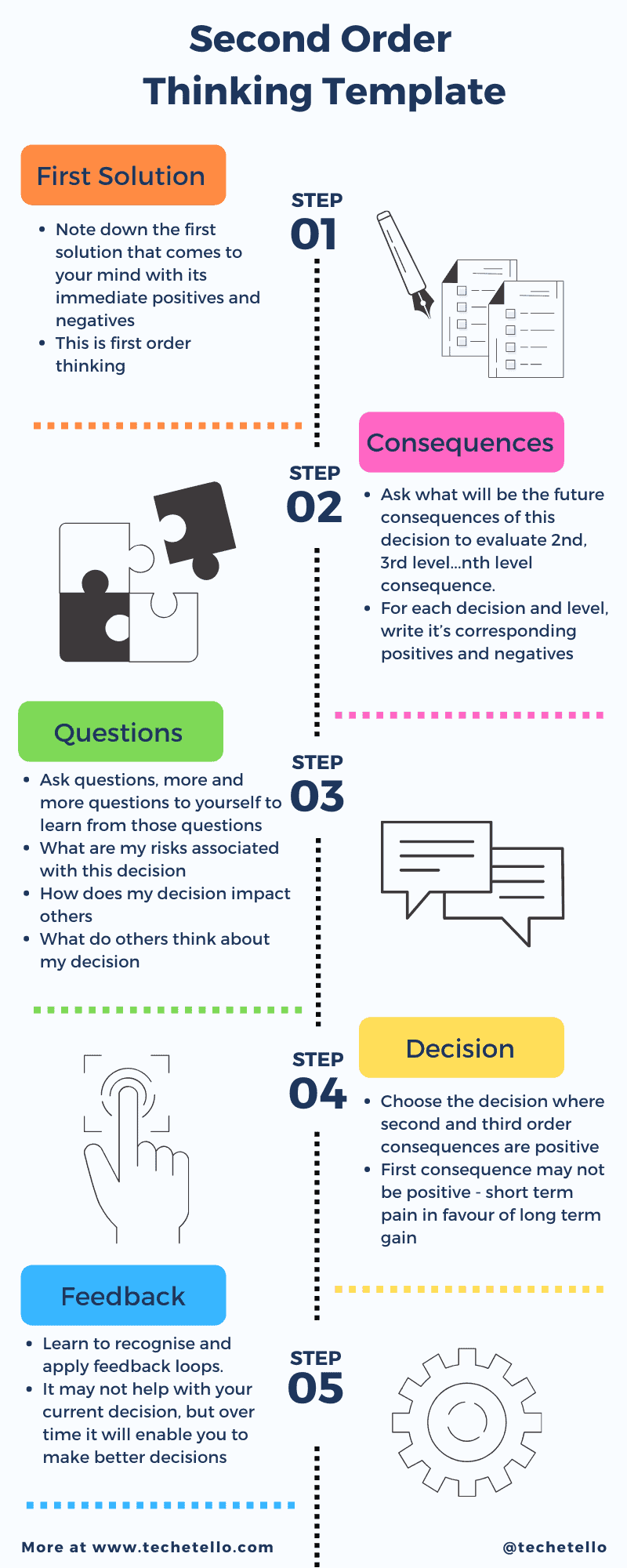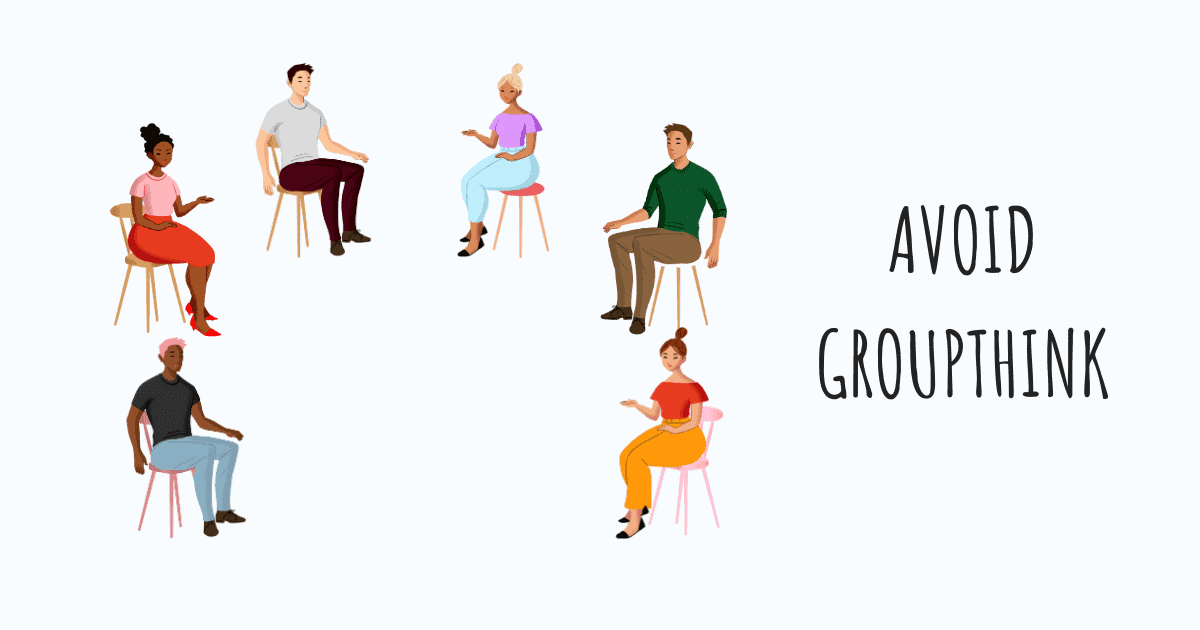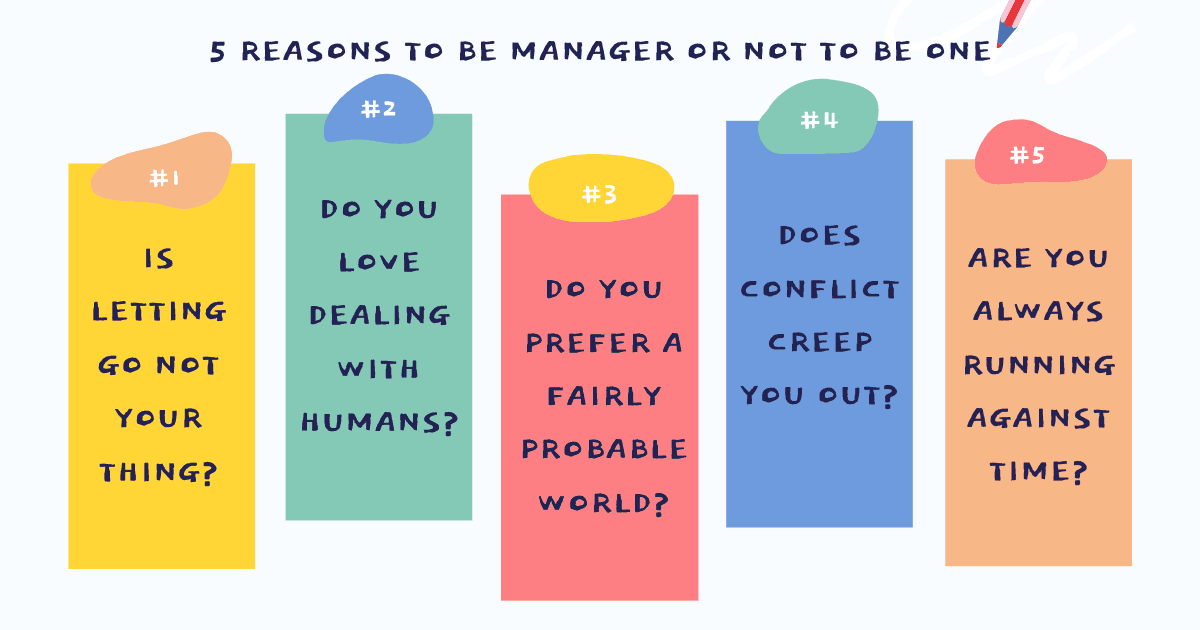Second Order Thinking: Thinking Practice To Make Better Decisions

While making decisions, how often do we optimize for long term gain at the cost of short term pain? A good process for making decisions requires second order thinking which unravels the implications of our decisions by thinking about its consequences in the future. It requires solving problems in a manner that avoids unintentional and unforeseen outcomes.
Second order thinking is a necessity to think beyond what we know, things we haven’t thought about by applying divergent information and forming new associations and connections.
It’s tempting to give in to good outcomes with small upside that are easily accessible and visible to us without weighing in on the potentially large downside of these decisions in the future. Our experiences and beliefs also limit our ability to go beyond the natural and seek hard truths by asking difficult questions, exploring unknown territories, and doubting what may seem like an obvious choice.
In organizations, encouraging high performance and good behavior through monetary rewards may seem like a natural choice in the short term. However, numerous studies have shown that without understanding the dynamics of your work environment, financial rewards may actually backfire or add no value to increase people’s motivation when analyzed over a long period of time. When designing policies, organizations need to think beyond “the simple and obvious” to “what’s not visible”.
What is second order thinking?
We stay inside a safety box that is easily accessible to us and guides us in making a large part of our decisions. It’s a blend of our environment and experiences that gives way to our thoughts and beliefs. How we think and what we decide is largely shaped and constrained by this box.
Second order thinking as a mental model requires going out of our comfort zone to think outside this box. It requires analyzing the potential impact of our decision into the future. It requires asking these questions:
- How can I make decisions with positive outcomes compounded in the future?
- Is this decision attractive only because it has an immediate effect (first order consequence) positive?
- What can be the potential downside of this decision and its effect later?
- How far can I look to determine how every subsequent decision creates a world of possibilities or limits the outcomes I can achieve?
Second order thinking provides a framework to make decisions by learning the second order consequences of our decisions and analyzing its impact in the near future. Going beyond second level thinking is difficult, but some people learn to expand their thinking to the third level and beyond by asking the same questions at each level.
Ray Dalio describes this very well in his book Principles
Failing to consider second- and third-order consequences is the cause of a lot of painfully bad decisions, and it is especially deadly when the first inferior option confirms your own biases. Never seize on the first available option, no matter how good it seems, before you’ve asked questions and explored.
Second Order Thinking Templates
Become a more effective decision maker by considering both the short-term and long-term implications of your choices.
Difference between first order thinking and second order thinking

Before we learn how to apply second order thinking to tap into the unknown, let’s understand the difference between first order and second order thinking. It’s important to differentiate between the two to make a conscious effort to shift from first order to second order thinking.
First order thinking is within the box thinking
First level thinking looks for easy answers driven by our past experiences and beliefs. It puts more weight on the immediate effect of our actions and ignores the subsequent impact. When we seek instant gratification, our first order thinking is at play.
It’s activated by system1 thinking which is intuitive and fast (Source: Thinking Fast And Slow by Daniel Kahneman). This form of thinking is really effective when we need to make quick decisions without exerting effort. A good part of our daily decisions falls into this category – what dress to wear to the office, where to meet a friend for dinner, and which turns to take while driving to work.
The conventional nature of first order thinking confines us to get the same results as everyone else.
In summary, first order thinking is safe, superficial, reactionary, obvious, fast, easy, and conventional with a focus on immediate impact.
Second order thinking is outside the box thinking
Second level thinking is hard and looks beyond our current assumptions and beliefs. It requires massive effort to dig out the potential impact of our decisions way into the future.
Given the complexity and uncertainty of our decisions, it involves system2 thinking which is deliberate and logical.
Going beyond intuition and seeking unconventional solutions by applying second order thinking philosophy is what separates great thinkers from the ordinary who outperform others and achieve greater success.
In summary, second order thinking is hard, complex, uncertain, and unconventional with a desire to explore potential future consequences and maximise its benefits.
Mind Map Templates
Work through complex problems, identify correlations, and see the big picture using these mind map worksheets.
How to develop second order thinking: Template to make better decisions

To develop second order thinking skills, let’s learn to evaluate the impact of first order effects by creating a template using these steps:
- Note down the first solution that comes to your mind with its immediate positives and negatives. This is your first order thinking.
- Then ask “What will be the future consequences of this decision” to evaluate the 2nd, 3rd level…nth level consequence. For each decision and level, write it’s corresponding positives and negatives.
- Ask questions, more and more questions to yourself to learn from those questions
- What are my risks associated with this decision?
- How does my decision impact others?
- What do others think about my decision?
- Why do I think my decision is right?
- Can I apply Occam’s razor to seek simpler solutions?
- Choose the decision where second and third order consequences are positive even though first may not be positive (short term pain in favor of long term gain).
- Learn to recognise and apply feedback loops. It may not help with your current decision, but over time it will enable you to make better decisions.
Once you adopt a second order thinking mental model and start applying its template in your decision process, you will see the positive results of your efforts compound over time.
Howard Marks, a great American investor and writer shares his views on first order and second order thinking,
The difference in workload between first-level and second-level thinking is clearly massive, and the number of people capable of the latter is tiny compared to the number capable of the former. First-level thinkers look for simple formulas and easy answers. Second-level thinkers know that success in investing is the antithesis of simple.
Cognitive Distortions Bundle
Challenge and replace irrational thoughts with more realistic and adaptive thoughts.
Examples of second order thinking
More often than not, our actions have unanticipated and unintended consequences. Let’s learn how first order thinking limits and second order thinking gives way to better decisions in real life with the help of a few examples.
Example 1: Managing crisis at work or avoiding one
When dealing with a crisis at work, a manager can adopt either first order or second order thinking.
First order thinking: I have done it in the past. I know how to do it way better than anyone else in the team. Let me take over and resolve it for now. My team can learn later.
First order thinking consequence: The manager needs to intervene every time there’s an issue since she never facilitated her team to solve problems on their own. She is constantly busy dealing with the crisis and never finds time for team development. The team does not feel empowered and people in the team do not grow which results in low team morale.
Second order thinking: I have done this in the past. I know how to do it way better than anyone else in the team. But, if I continue solving it, I will never give an opportunity to my team to step up and resolve issues on their own. This is an excellent opportunity for my team to learn how to manage and deal with crisis situations. I will be available to guide them through the process.
Second order thinking consequence: In the first few instances, the team may struggle and take slightly longer to resolve. However, they will be better equipped to handle such issues on their own in the future. It will free up the manager’s time to do effective planning that reduces the number of such crisis situations. The team also feels motivated and empowered to do more, better.
In this example, first order thinking has short term benefits with long term negative impact. Second order thinking has a short term pain with multiple benefits in the long run. Which one will you choose as a manager?
Example 2: Hiring for now vs the future
While making a hiring decision for a position that’s open for a long time, a hiring manager can either apply first order or second order thinking.
First order thinking: I really need to fill this role. Many projects will be delayed if I do not get someone to start immediately. This person seems like the best fit for the current role. She has certain gaps that may be challenging for my future needs. But, we can attend to them when the time comes. Let’s hire her.
First order consequence: The new hire is able to get the projects started. As these projects increase in complexity, she starts facing challenges in providing direction and guidance to her people. This leads to communication gaps, lack of clarity, and poor collaboration causing multiple project delays. The culture of the organization also takes a hit as constructive arguments become destructive and employees start blaming other teams and functions for missing their deadlines and not achieving results.
Second order thinking: I really need to fill this role. Many projects will be delayed if I do not get someone to start immediately. This person seems like the best fit for the current role. But, she has gaps that will be challenging for the future demands of this position. I need to hire someone who can meet my requirements for the future and not just my current needs. While the next few months will be tough, the right thing to do will be to keep looking till we find someone suitable.
Second order consequence: Projects get to a slow start. However, within the next few weeks, people in the team step up to take additional responsibilities. Meanwhile, the hiring manager is also able to bring a strong leader with great potential and required qualities inline with the future demands. The new leader rallies the team through strong clarity, sense of purpose and direction that motivates employees to put their best effort forward. The team is able to make great progress under her direction and achieve substantial results.
This is a great example of why applying second order thinking is crucial while making hiring decisions to hire the right talent in an organization.
A deliberate attempt to apply second order thinking while making important decisions can provide a huge advantage to organizations and their people. I hope to inspire you to think differently, make that extra effort to visualise the future and reap its many benefits.
What are your thoughts about applying this mental model at work and in life? Write to me or share your views in the comments below.































It was great.
Thanks Ali
got an aha moment. This is great stuff.
Thanks Fred
Great article. Explained very well!
Thank you Braden